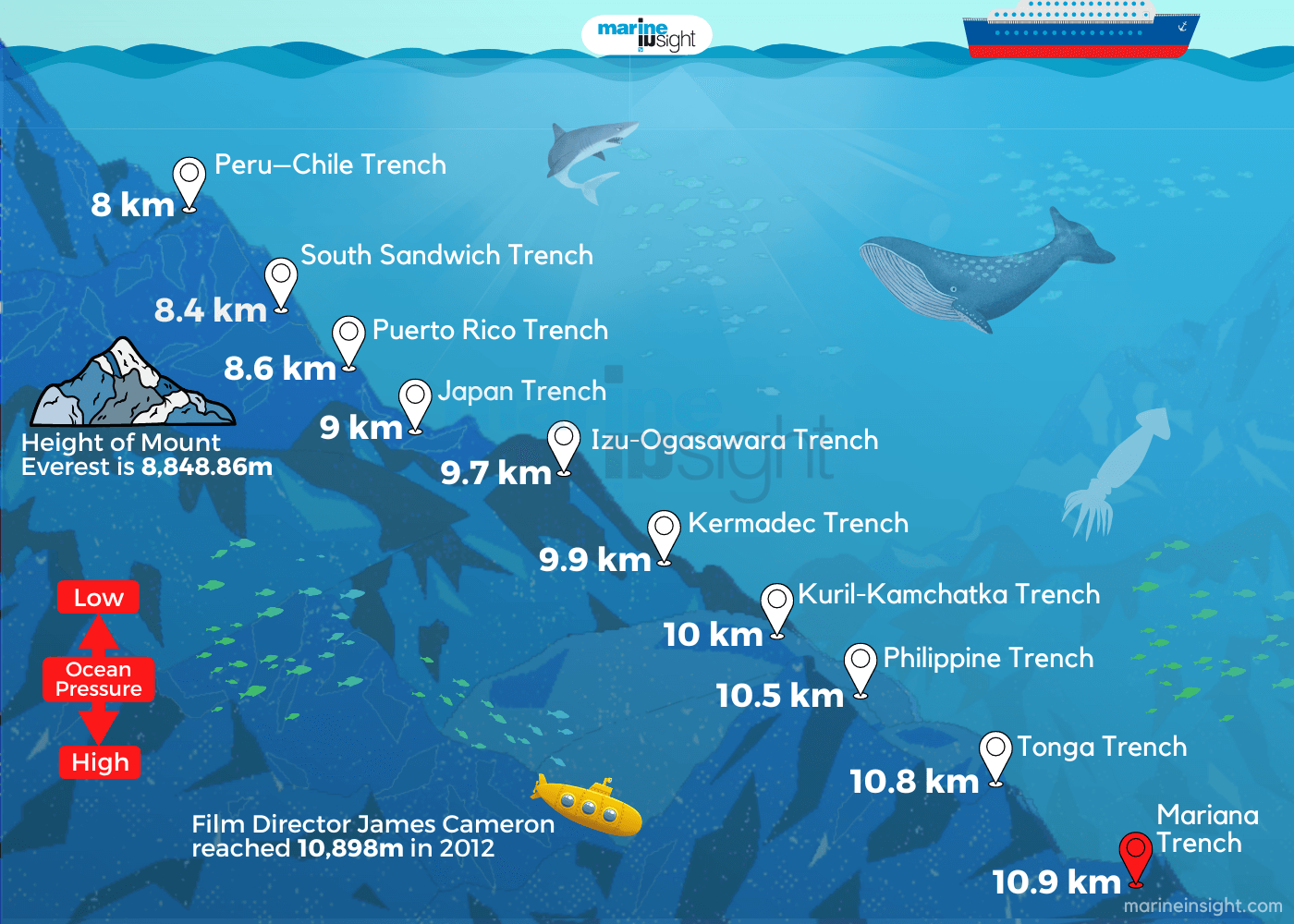Image Credits: Marine Insight.
The deepest point on Earth is known as the Challenger Deep, located in the Mariana Trench in the western Pacific Ocean. Here’s a detailed overview:
1. Location
- Coordinates: The Challenger Deep is situated at approximately 11°22.4′N 142°35.5′E.
- Mariana Trench: The Mariana Trench is a crescent-shaped trench in the floor of the western Pacific Ocean, to the east of the Mariana Islands.
2. Depth
- Maximum Depth: The Challenger Deep is the deepest known point in the Earth’s seabed, with an estimated depth of about 10,984 meters (36,037 feet or 6.83 miles) below sea level, though measurements vary slightly depending on the method used.
- Comparison: To put this in perspective, if Mount Everest (the highest point on Earth at 8,848 meters) were placed into the Challenger Deep, its peak would still be submerged by over 2 kilometers of water.
3. Exploration
- First Manned Descent (1960):
- The first human descent into the Challenger Deep was made by the bathyscaphe Trieste, piloted by Swiss engineer Jacques Piccard and U.S. Navy Lieutenant Don Walsh. They reached a depth of about 10,916 meters.
- James Cameron’s Solo Dive (2012):
- Filmmaker and explorer James Cameron made a solo descent to the Challenger Deep in the submersible Deepsea Challenger, reaching a depth of 10,908 meters. He spent several hours at the bottom collecting data and samples.
- Recent Expeditions:
- Since Cameron’s dive, several other expeditions have explored the Challenger Deep, including dives by unmanned submersibles and other manned missions.
4. Environmental and Geological Features
- Trench Formation: The Mariana Trench, including the Challenger Deep, was formed by the subduction of the Pacific Plate beneath the smaller Mariana Plate. This tectonic activity causes the ocean floor to be pushed down to extreme depths.
- Pressure: At the bottom of the Challenger Deep, the pressure is more than 1,000 times the standard atmospheric pressure at sea level, which is approximately 1,086 bars (15,750 psi).
- Temperature: Despite the extreme pressure, the temperature near the bottom remains just above freezing due to the constant cold of the deep ocean water.
5. Marine Life
- Extreme Environment: Despite the harsh conditions, life exists at these depths. Organisms such as xenophyophores, amphipods, and small sea cucumbers have been discovered.
- Adaptations: These organisms have unique adaptations to survive the extreme pressure, darkness, and low temperatures.
6. Scientific Importance
- Research: The Challenger Deep is of great interest to scientists studying the extremes of life on Earth, plate tectonics, and the geology of subduction zones.
- Sample Collection: Expeditions to the Challenger Deep have provided samples of sediment and microbial life, offering insights into the biochemical processes that occur under such extreme conditions.
7. Cultural Significance
- Symbol of Exploration: The Challenger Deep represents one of the final frontiers of exploration on Earth. Its extreme conditions and remote location symbolize the challenges and triumphs of human curiosity and exploration.
8. Challenges
- Technical Difficulties: The extreme pressure, darkness, and remoteness make exploring the Challenger Deep extremely difficult and expensive. Specially designed submersibles and equipment are required to withstand the conditions.

